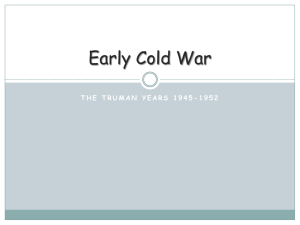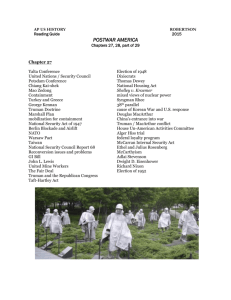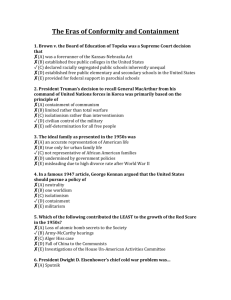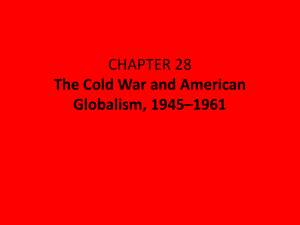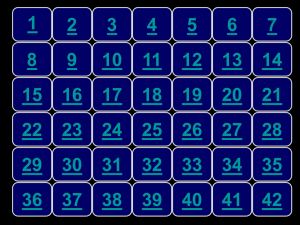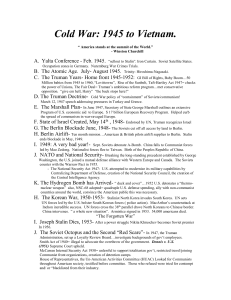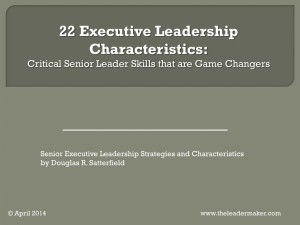Chapter 18 outline
advertisement
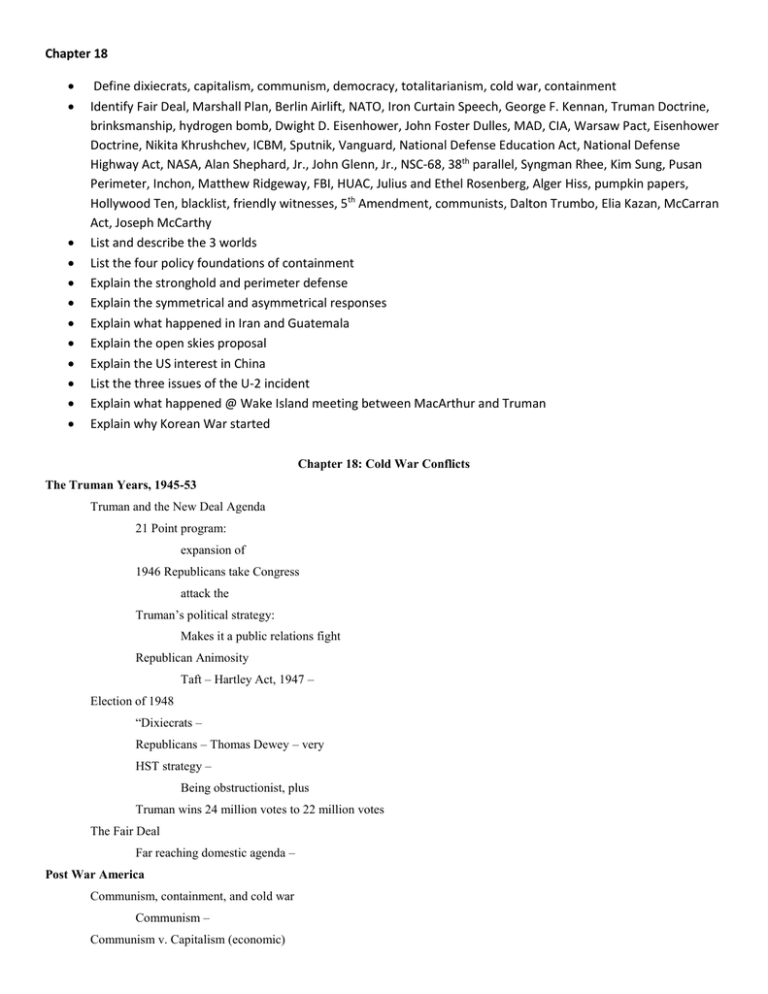
Chapter 18 Define dixiecrats, capitalism, communism, democracy, totalitarianism, cold war, containment Identify Fair Deal, Marshall Plan, Berlin Airlift, NATO, Iron Curtain Speech, George F. Kennan, Truman Doctrine, brinksmanship, hydrogen bomb, Dwight D. Eisenhower, John Foster Dulles, MAD, CIA, Warsaw Pact, Eisenhower Doctrine, Nikita Khrushchev, ICBM, Sputnik, Vanguard, National Defense Education Act, National Defense Highway Act, NASA, Alan Shephard, Jr., John Glenn, Jr., NSC-68, 38th parallel, Syngman Rhee, Kim Sung, Pusan Perimeter, Inchon, Matthew Ridgeway, FBI, HUAC, Julius and Ethel Rosenberg, Alger Hiss, pumpkin papers, Hollywood Ten, blacklist, friendly witnesses, 5th Amendment, communists, Dalton Trumbo, Elia Kazan, McCarran Act, Joseph McCarthy List and describe the 3 worlds List the four policy foundations of containment Explain the stronghold and perimeter defense Explain the symmetrical and asymmetrical responses Explain what happened in Iran and Guatemala Explain the open skies proposal Explain the US interest in China List the three issues of the U-2 incident Explain what happened @ Wake Island meeting between MacArthur and Truman Explain why Korean War started Chapter 18: Cold War Conflicts The Truman Years, 1945-53 Truman and the New Deal Agenda 21 Point program: expansion of 1946 Republicans take Congress attack the Truman’s political strategy: Makes it a public relations fight Republican Animosity Taft – Hartley Act, 1947 – Election of 1948 “Dixiecrats – Republicans – Thomas Dewey – very HST strategy – Being obstructionist, plus Truman wins 24 million votes to 22 million votes The Fair Deal Far reaching domestic agenda – Post War America Communism, containment, and cold war Communism – Communism v. Capitalism (economic) Capitalism – Communism – Democracy v. Totalitarianism (political) Democracy – Totalitarianism – Cold War What is it? – Sources of conflict 1. Soviets in E. Europe – 2. Instability in Third World – First world – Second world – Third world – 3. Atomic Age and Diplomacy – Early conflicts Marshall Plan, 1948 – Help them rebuild, Berlin Airlift, 1948-9 – Test of Allies’ Stalin backs down – North Atlantic Treaty Organization, 1949 – U.S. and 11 other nations Major Events in US 1946 – Winston Churchill – Iron Curtain speech 1946 – George F. Kennan – Containment- “Long Telegram” – 1. 2. US job is to Result: 1947 – Truman Doctrine – 1947 – National Security Act of 1947 – Operationalizing Containment Not a military policy Four policy foundations 1. disagreements – 2. concessions – 3. US military – 4. Negotiations – Goals of containment 1. restore balance of power 2. reduce SU ability to project influence 3. long term “behavior modifications” How does it work? Stronghold v. Perimeter defense Stronghold – Centers: Perimeter – Asymmetrical v. Symmetrical response Symmetrical – Asymmetrical – On the Edge Race for the H-bomb Atomic bomb – Hydrogen bomb (thermonuclear) – 67 times Soviet A-bombs Take away American advantage U.S. needed to 1952 – 10 times more 1953 Soviets duplicate Brinkmanship 1952 – Dwight D. Eisenhower Secretary of StateCompromise New foreign policy MAD – Great dependence on nukes and planes – Soviet response – Cold War Spreads CIA – Central Intelligence Agency – Covert actions (secret operations) – Middle East and Latin America 1951 – Iran – Western nations Economy plummets 1953 – CIA persuades the Shah of Iran (monarch) 1954 – Guatemala – CIA trained army Geneva Summit 1953 – Soviets recognize 1955 – West Germany Warsaw Pact – 1955 – Geneva, Switzerland U.S. – SU/US allow flights over each other’s territories Summit really accomplishes little, but “spirit of Geneva” Crisis in the Middle East 1948 – agree to 1955 – Great Britain help Nasser (head of Egypt) Great Britain/ U.S. Nasser seized Suez Canal 1956 – GB, FR, Israel invaded Egypt SU threatens to use missiles War avoided – 1956 – Nikita Khrushchevcriticized Stalin Soviet prestige increases 1957 – Eisenhower Doctrine Congress approves it – Science and Education in the Cold War U.S. believed military technology better than SU 1957 – SU announce ICBM October 4, 1957 – SU launches Sputnik I Possibility of dropping U.S. feels Falling behind in First attempts National Defense Education Act, 1957: National Defense Highway Act, 1956: Increase 1958 – U.S. creates NASA – U.S. successfully launched Second satellite: 1961- Soviet Union has the U.S. – Alan Shepard, Jr. 1962 – John Glenn, Jr. – 1963 – Soviet Union has 1964 – Soviet Union is the first Why the difference in accomplishments? Soviet Union United States U-2 Incident CIA – Plane – U-2 – Took Issues: 1. Existence and purpose of flights – 2. Soviets 3. Eisenhower Summit on Arms Race SU brought down u-2 flight – US story – SU – Francis Gary Powers confesses US openly admits truth – Tensions at ultimate high – Powers criticized for not Cold War Heats Up Soviets explode bomb, 1949 “Fall of China”, 1949 – US interest – Mao Tse tung v. Chiang Kai-shek Mao – Chiang – US fear – NSC- 68, 1950 Document by National Security Council (UN) Recommendations: Options: 1. Continue 2. revert 3. wage 4. increase want to move towards increase spending HST very skeptical – policy hard to sell to the public, but… Korean Conflict, 1950-3 38th parallel – Syngman Rhee v. Kim Sung Rhee – Sung – June 25, 1950: “Pusan Perimeter” U.S. and allies pushed Soft occupation duty Douglas MacArthur – Goal: Inchon, September, 1950 Battle plan: Inchon importance: Attack plan: Then MacArthur invades with an amphibious invasion Why? cuts off Successful: New Goal: From MacArthur becomes a hero MacArthur presses on to the Yalu River Chinese reaction: warns Chinese help NK Douglas MacArthur v. Truman Meet at Wake Island – MacArthur threatens China 200,000 MacArthur wants authority Truman fears widening the war – MacArthur issues own statement MacArthur is fired for Goal changes: Results: 1952 – peace talks stalled – 1953 – Armistice signed – war ends where it began: Armistice nominally still in effect – Tally: 36,576 U.S. troops killed 8142 Missing in Action 2 million Koreans (NK and SK estimated) 1.5 million Koreans civilians estimated 20 billion dollars spent 75 million tons of material used 3.3 million tons of ammunition Red Scare and McCarthyism Fear of internal communist subversion Federal Loyalty Review Program, 1947 Finding disloyalty to US government 4.7 million 350-500 2500 questioned Attorney General’s List, 1947 Creates list of subversive organizations FBI – Federal Bureau of Investigation: (J. Edgar Hoover) in charge of investigations 2 cases Whittaker Chambers – Alger Hiss, 1948 Chambers accused of subversion Pumpkin papers Documents typed Hiss defense – Julius and Ethel Rosenberg, 1953 Klaus Fuchs admitted Inconclusive evidence – but they First Americans Execution: David Greenglass confessed in Children – two sons, House Un-American Activities Committee, 1945-53 (HUAC) One of several organizations Changes its focus to Hollywood “Hollywood Ten” – Blacklist – Hard to Friendly witnesses – Fifth Amendment communists – Dalton Trumbo – Elia Kazan – McCarran Act, 1950 (Internal Security Act) Supported by Registration requirement McCarthyism, 1950-4 Senator Joseph McCarthy – Wisconsin (R), War Hero, a nobody until 1950, Wheeling, WV: claims to have a list continually changes facts and figures attempts to discredit his critics End of McCarthyism, 1954 Accuses President Eisenhower and US Army
